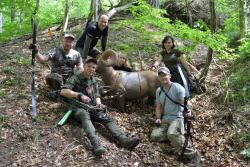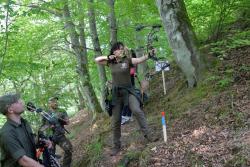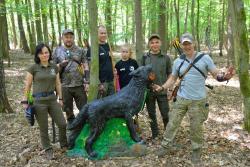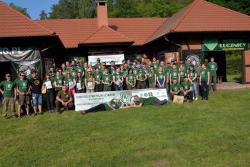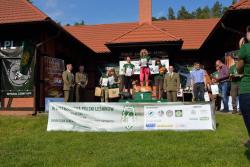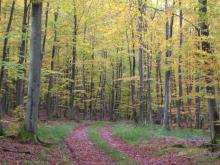 Asset Publisher
Asset Publisher
Polish forests
Poland is in the European lead, while concerning the area of all forests. They cover about 29,2 % of the country territory, and grow within the area of 9,1 million hectares. The overwhelming majority of the forests is state owned, of which almost 7,6 million hectares are managed by the State Forests National Forest Holding..
The number of Polish forest is still growing. The forestation rate of the country has increased from 21 % in 1945 to 29,2 % at the moment. Between 1995 and 2008, the forest area increased by 310 thousand ha. The basis for afforestation works is the "National Programme for Increasing the Forest Cover" (KPZL), assuming an increase of the forestation rate up to 30 % by 2020 and up to 33 % by 2050. Polish forests abound in flora, fauna and fungi. 65 % of the total number of animal species live there.
The forests grow in our country on poor soils, mainly because of the development of the agriculture in previous years. It influences the distribution of the types of the forest sites in Poland. Over 55 % of the forest areas is covered with coniferous forests. In other areas, there are forest sites, mainly the mixed ones. Their small part constitute alder and riparian forests – not more than 3 %.
In the years 1945 – 2011 the area of natural deciduous tree stands within the area of the State Forests National Forest Holding increased from 13 to 28,2 %.
Within the lowlands and uplands the most often occurring tee species is pine. It covers 64,3 % of the forest area of the State Forests National Forest Holding and 57,7 % of private and commune forests. In the mountains the predominant species is European spruce ( in the west) and European spruce with beech (in the east). Domination of pine is the result of carrying on sustainable forest management in the past. Once, the monocultures (crops or cultivations of one species) were the answer to the great demand of industry for wood. Such forests appeared to be quite fragile to climatic factors. They also were often the prey of pests' expansion.
In Polish forests, the share of other tree species, especially deciduous trees have been systematically increasing. The foresters have stepped aside from monocultures – that is why, they try to fit specific species of the forest stand to the natural stand, that would be proper for the given area. Thanks to that, in the years 1945 – 2011, the area of the deciduous tree stands within the lands of the State Forests National Forest Holding increased from 13 to 28,2 %. There occur more and more frequently the following tree species: oaks, ashes, maples, sycamore maples, elms, but also birches, beeches, alders, poplars, hornbeams, aspens, tilias and willows.
Our forests are the most often represented by the forest stands aged 40 to 80 years. The average age of the forest equals 60 years. More and more trees are of big size at the age over 80 years. Since the end of the Second World War, the forests' area has increased up to almost 1,85 million hectares.
Raport o stanie lasów w Polsce 2012
 Asset Publisher
Asset Publisher
III Mistrzostwa Polski Leśników w Łucznictwie 3D o puchar Dyrektora Generalnego Lasów Państwowych- Warcino 2019
III Mistrzostwa Polski Leśników w Łucznictwie 3D o puchar Dyrektora Generalnego Lasów Państwowych- Warcino 2019
III Mistrzostwa Polski Leśników w Łucznictwie 3D o puchar Dyrektora Generalnego Lasów Państwowych
Dzień 1 czerwca w naszym Nadleśnictwie upłynął pod znakiem szczególnego wydarzenia. Tego właśnie dnia Nadleśnictwo Warcino na swoim terenie zorganizowało III Mistrzostwa Polski Leśników w Łucznictwie 3D o puchar Dyrektora Generalnego Lasów Państwowych Łucznictwo 3D to konkurencja sportowa, która pozwala ćwiczyć trudną sztukę strzelania w lesie przy migotliwym świetle , zasłaniających gałęziach i do celu, pod różnymi kątami. W tej konkurencji stawia się na realizm sytuacji tak, aby jak najbardziej przypominała prawdziwe polowanie na zwierza. Obowiązuje w niej zasada jednego celnego strzału. To najprościej mówiąc polowanie na figury zwierząt naturalnej wielkości, które poustawiane są w drzewostanach. Do rywalizacji w „warcińskich” lasach przystąpiło 56 miłośników tej prastarej broni myśliwskiej. Przybyli do nas by rywalizować w 3 kategoriach sprzętowych: Łuk bloczkowy, Łuk tradycyjny, Łuk typu Hunter. Trasa wyznaczona została wzdłuż urokliwej rzeki Wieprzy, nieopodal Leśnego Pensjonatu Kawka. Na trasie liczącej ponad 4 km organizatorzy zainstalowali 28 figur zwierząt w skali 1:1. Były to m.in. jelenie, muflon, sarna, jenot, dzik, lis i kaczka. Zawody nie należały do najłatwiejszych, lecz ranga mistrzostw była też nie mała ,gdyż walka toczyła się o najważniejsze trofeum czyli Puchar Dyrektora Generalnego Lasów Państwowych. Każdy uczestnik otrzymał pamiątkową koszulkę oraz odznakę a zwycięzcy nagrody i puchary.
Zwycięzcami pierwszych miejsc w poszczególnych kategoriach byli:
Łuk bloczkowe kobiety – Anna Kulik Nadleśnictwo Świeradów
Łuk tradycyjny kobiety- Agnieszka Knioła UP Poznań
Łuk typu Hunter kobiety- Gabriela Żak –Technikum Leśne w Goraju
Łuk typu Hunter mężczyźni- Piotr Migdalski UP Poznań
Łuk tradycyjny Mężczyźni- Hubert Guździoł Nadleśnictwo Antonin
Łuk bloczkowy mężczyźni- Grzegorz Dworszczak Nadleśnictwo Warcino
Na zakończenie wszyscy uczestnicy spotkali się przy wspólnym ognisku a Nadleśniczy Nadleśnictwa Warcino obiecał ,że w roku 2020 spotkamy się 6 czerwca na IV Mistrzostwach Polski. Mistrzostwa o Puchar Dyrektora Generalnego Lasów Państwowych zostały zorganizowane przy współpracy Nadleśnictwa Warcino, Sekcji Łuczniczej Koła Leśników Wydziału Leśnego Uniwersytetu Przyrodniczego w Poznaniu, Stowarzyszenia Noteccy Łucznicy, Firmy Bowhunting , Koła Łowieckiego Hubert w Słupsku, Firmie Adkonis oraz Związku Leśników Polskich w RP.


 fot. Paweł Fabijański
fot. Paweł Fabijański
 fot. Paweł Fabijański
fot. Paweł Fabijański
 fot. Paweł Fabijański
fot. Paweł Fabijański

